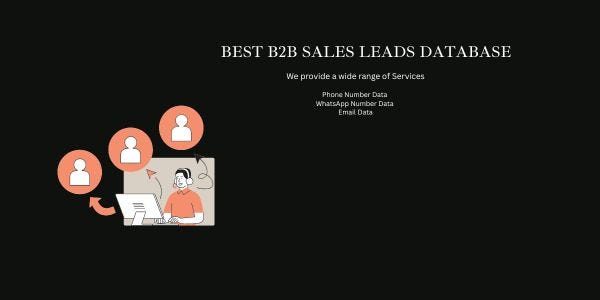Lead capture is an essential strategy for keeping sales flowing, as it sparks interest and educates potential prospects about your product or service. The process increases the visibility of the brand you represent and generates numerous opportunities for your sales team. In this post, we'll explain what lead generation is, how it works, and the key tools that make up a successful operation. Read on to discover important facts about the practice. Key takeaways from this article: Lead management aims to attract and qualify prospects. This way, you guide them to the bottom of the sales funnel and help them recognize the value of your products and services. One way to capture Best B2B Sales Leads Database is to produce informative and relevant content .
Another way to capture Best B2B Sales Leads Database is through your company's own customer base . Satisfied customers are always willing to recommend your business to friends and acquaintances. Your company's website is a great source of lead generation in itself . To capture them, you can include contact request forms. In addition to capturing Best B2B Sales Leads Database, you need to understand how Best B2B Sales Leads Database to guide them to the next stages of the sales funnel . To take your first steps in this strategy, you must master the art of prospecting clients. Furthermore, having a CRM system helps you manage your Best B2B Sales Leads Database and ensure you maximize your opportunities. Ready? Then let's go! Read also: Is buying Best B2B Sales Leads Database worth it? What are the alternatives? What is a lead? A lead is a potential customer for your company.
As an evolved form of prospect, this consumer has chosen to share their contact information with your brand. This initial interaction marks the beginning of the discovery phase, placing them at the top of the sales funnel and demonstrating their willingness to receive information that will lead them to the end of the purchasing journey. Initially, the information provided is basic, including name, phone number, and email address, for example. This is enough to begin the lead nurturing process, in which the lead receives materials that help them understand their needs and the solutions they can find with your brand. Of course, they don't share their information "for free." To convince them to do so, you need to use a bargaining chip—an item that represents value to the target audience and already works to educate them about what the company has to offer. In digital marketing, the strategy usually involves making e-books, infographics, and other rich materials available to online users by filling out a simple form.

Also check out: Learn what Best B2B Sales Leads Database are and 8 tips to win them over What is a qualified lead? A lead is a prospect who has demonstrated a basic level of interest in the type of solution your company sells. This doesn't mean they're ready to receive a business proposal as soon as they share their information. As mentioned, this potential customer begins their journey at the top of the funnel. They're generally not ready or even considering making a purchase at this stage. Therefore, there's a high chance they'll decline an offer and lose interest in your brand if they perceive an overly "aggressive" approach right away.